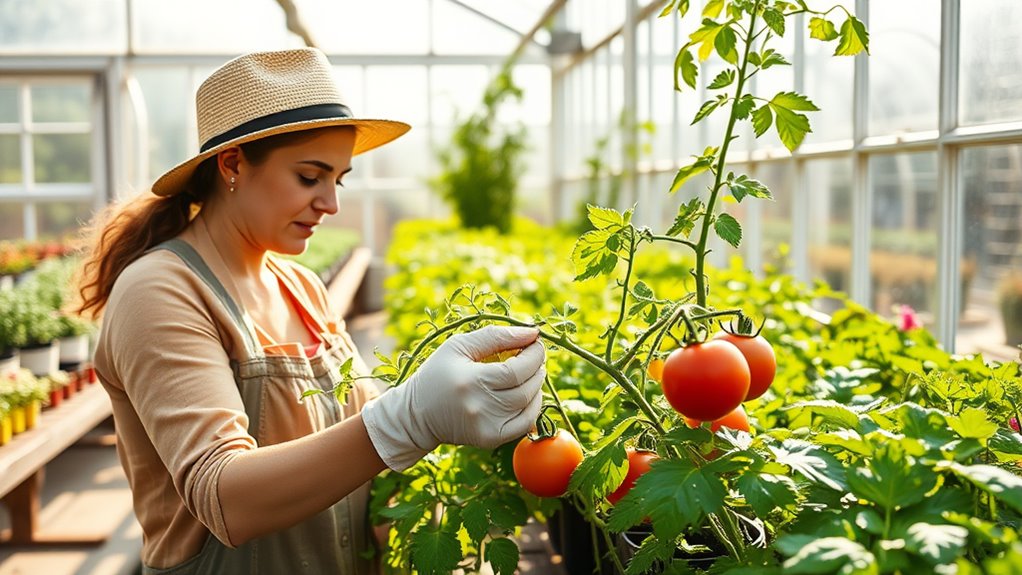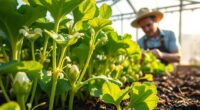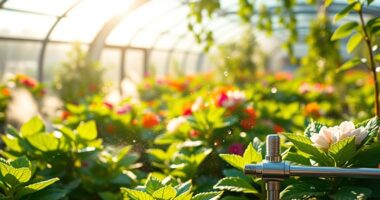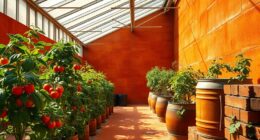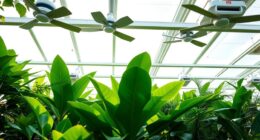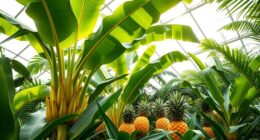Pruning and training plants in a greenhouse is essential for boosting their health and productivity. By selectively trimming, you’ll improve air circulation and light penetration, which helps prevent diseases. Use the right tools for effective pruning, and time your efforts right—usually in late winter or early spring. Consider specific training methods like trellising or low-stress techniques to support growth. There’s much more to discover about optimizing your greenhouse practices!
Key Takeaways
- Pruning enhances plant health by improving air circulation and light penetration while reducing disease risks in the greenhouse environment.
- Use appropriate tools like pruning shears, loppers, and saws for effective pruning and training of various plant sizes.
- Apply techniques such as pinching and thinning to control shape and promote optimal growth while avoiding excessive stress on plants.
- Timing is crucial; prune in late winter or early spring to encourage healthy new growth and avoid late summer pruning.
- Implement training methods like trellising and low-stress techniques to support plant structure and maximize yield in the greenhouse.
Importance of Pruning in Greenhouses

When you prune plants in a greenhouse, you’re not just trimming away excess growth; you’re actively enhancing their health and productivity.
Pruning improves air circulation, reducing humidity and minimizing the risk of fungal infections. By removing excess foliage, you allow light to penetrate, promoting healthy growth. It also keeps plants healthy by eliminating dead or diseased parts, preventing the spread of pests.
Pruning enhances air circulation, reduces humidity, and prevents pests, ensuring healthy growth and optimal light penetration for your plants.
Moreover, pruning supports even nutrient distribution, leading to better growth and yield. For vining crops like tomatoes and cucumbers, regular pruning is crucial for maintaining productivity.
Ultimately, effective pruning maximizes greenhouse space and optimizes plant architecture, setting the stage for robust, high-quality yields.
Effective Pruning Techniques
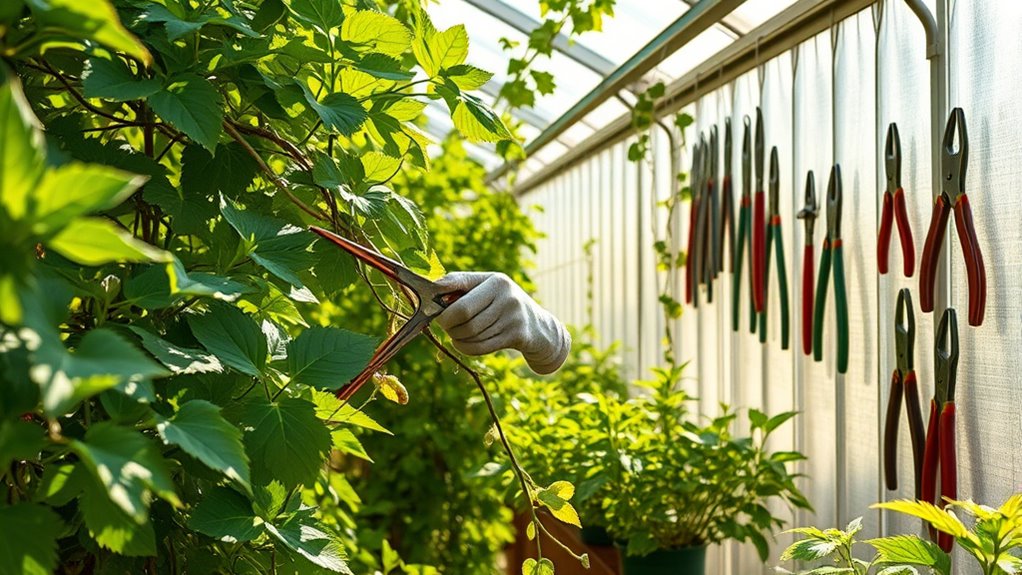
Effective pruning techniques are essential for maximizing the health and productivity of greenhouse crops. Start by using the right tools, like pruning shears and loppers, depending on branch size. Your objectives should include balancing growth, enhancing light penetration, and reducing disease risk.
Techniques such as pinching, thinning, and heading cuts help control plant shape and size effectively. For specific crops, remove suckers and lower leaves from tomatoes, pinch sweet pepper growth points, and apply the umbrella renewal system for cucumbers.
Focus on air circulation by selectively removing leaves, improving airflow and reducing disease susceptibility. Remember, pruning shouldn’t exceed one-third of the plant to avoid stress, and always clean your tools to prevent disease spread.
Happy pruning!
Timing and Frequency of Pruning

Understanding the timing and frequency of pruning is crucial for plant health and development. You can prune any time of year, but late winter or early spring is ideal for most plants, just before new growth starts.
Avoid pruning right after spring growth, as it can hinder development. Limit late summer pruning to prevent promoting new growth that won’t harden off before winter.
Regular annual pruning helps maintain plant health and prevents overgrowth. Keep in mind that evergreen shrubs need less frequent pruning than deciduous ones.
Adjust your pruning frequency based on each plant’s growth rate and desired shape, ensuring you don’t stress them by pruning too often or allowing them to become overgrown.
Training Methods for Optimal Growth

To achieve optimal growth, you can employ various training methods tailored to your plants’ specific needs.
Low-stress techniques like tie and bend or SCROG training are great for increasing yield while minimizing plant stress. If your plants are vining, consider the drape method or trellising to support their growth and improve air circulation.
High-stress methods, such as topping or defoliation, can stimulate growth and enhance light exposure, but use them judiciously.
Remember, specific crops like tomatoes or cucumbers require distinct training approaches for the best results.
Utilize printed protocols and visual aids to guide your training process, ensuring that you’re following best practices for maximum yield and plant health.
Benefits of Proper Training and Pruning
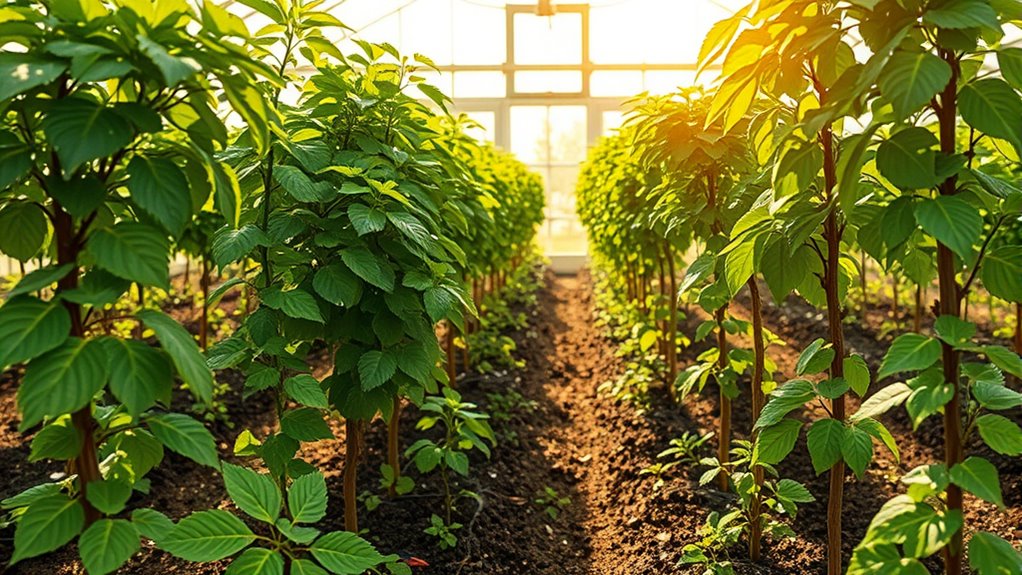
While you might think training and pruning are merely aesthetic choices, they play a crucial role in the health and productivity of your plants. Proper training improves structure, ensures even sunlight exposure, and enhances air circulation, reducing disease risks.
You’ll also maximize space, making maintenance easier. Pruning, on the other hand, removes dead or diseased parts, stimulating new growth and controlling size.
This combination not only optimizes growth patterns but also increases crop yield and plant vigor. With regular training and pruning, you’ll find managing your greenhouse becomes simpler and more efficient.
Ultimately, these practices lead to healthier plants, better air quality, and increased economic returns, making them essential for any successful greenhouse operation.
Tools and Equipment for Pruning and Training

Having the right tools is essential for effective pruning and training of plants. Start with hand pruners for branches up to 3/4 inch and loppers for those between 3/4 to 1-1/2 inches. For thicker wood, a pruning saw is your best bet. If you’re reaching high branches, opt for a pole saw.
For training, trellises and clips will support vining plants, while stakes and twine keep stems upright. Don’t forget ergonomic handles and durable materials to ensure comfort and longevity.
Regularly sanitize, sharpen, and inspect your tools to maintain their effectiveness. With the right equipment, you’ll promote healthy growth and keep your greenhouse flourishing.
Crop-Specific Training Considerations
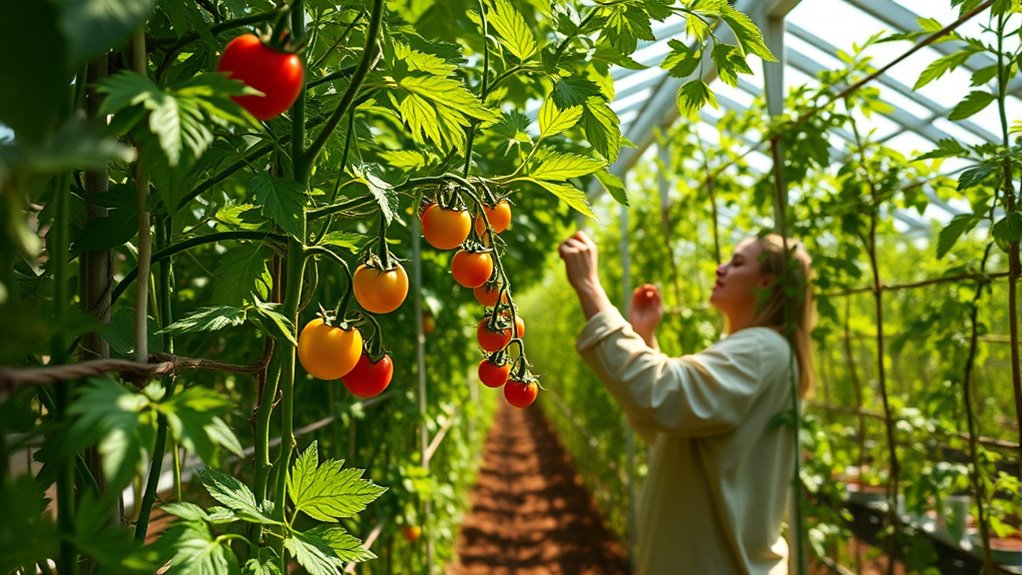
Choosing the right crops for training in your greenhouse can significantly impact your success and profitability. Focus on market demand to ensure you’re growing what’s profitable.
Select crops that thrive in your controlled environment, considering their growth patterns—vining crops like tomatoes benefit from trellising and staking, while bush types may need different approaches. Research indicates that hands-on learning experiences can enhance crop management techniques for better yields.
Pay attention to light and nutrient requirements, as these will influence your training strategies. Prune vining crops to control growth and enhance fruit quality, ensuring you maintain a balance between energy production and consumption.
Regularly monitor plant health and adapt your techniques based on real-time data. By tailoring your training methods to specific crops, you’ll optimize growth and yields. Additionally, incorporating plants like aloe vera can provide beneficial effects, such as improving soil quality and increasing overall plant vitality.
Frequently Asked Questions
What Are the Signs That a Plant Needs Pruning?
You’ll notice your plant needs pruning when you see dead or dying branches, which lack leaves and feel brittle.
If the plant looks overgrown, it might block light or pathways.
Watch for misshapen growth with uneven branches that could lead to structural issues.
Additionally, if air circulation seems poor due to dense foliage, it’s a sign that thinning out branches could improve your plant’s health and encourage new growth.
Can Pruning Affect Plant Flowering and Fruiting?
“You can’t make an omelet without breaking a few eggs.”
Pruning can significantly affect a plant’s flowering and fruiting. By removing certain parts, you disrupt the balance between growth types, often promoting more flowers.
While light pruning can boost blooms, heavy pruning might delay fruiting in younger plants but invigorate mature ones.
Timing and technique matter, as they can enhance growth and improve overall quality, benefiting both flowers and fruits.
How Can I Tell if My Pruning Technique Is Effective?
To tell if your pruning technique is effective, observe your plants closely.
Look for healthy new growth, vibrant leaves, and an increase in flowering or fruiting. If you notice improved air circulation and reduced disease symptoms, that’s a good sign.
Additionally, check for balanced shape and structure—plants should appear well-maintained.
Keep track of yield and quality; consistent and robust production indicates that your pruning methods are working as intended.
Is It Safe to Prune During Extreme Weather Conditions?
Did you know that nearly 30% of tree damage occurs during extreme weather? It’s not safe to prune when conditions are severe. High winds or heavy snow can create hazards that make pruning risky.
You should assess any damage from a safe distance first. If you see hanging branches or significant damage, hire a professional.
What Common Mistakes Should I Avoid While Pruning?
When you’re pruning, avoid common mistakes that can harm your plants.
Don’t prune during extreme weather or at the wrong time of year; it stresses the plants. Make sure your cuts are clean and at the right angle to prevent water accumulation and disease.
Don’t over-prune, as this weakens them, and avoid under-pruning, which leads to overcrowding. Always use sanitized tools to prevent spreading diseases between your plants.
Conclusion
In conclusion, mastering pruning and training techniques can significantly enhance your greenhouse plants’ health and productivity. For instance, a gardener who regularly prunes their tomato plants not only boosts airflow but also increases fruit yield. By committing to these practices, you’ll promote stronger growth and a bountiful harvest. So, grab your tools and start shaping your plants for success—your greenhouse will thank you!
